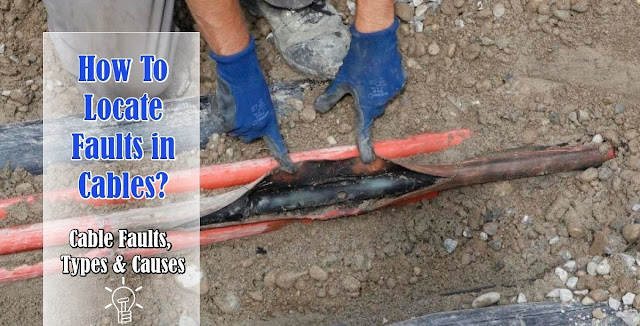Introduction to Faults in Cables
When electrical energy is generated in the generations’ stations, it is distributed to the different loads, i.e. cities, towns and villages for consumption then. The process involves stepping up the voltage to minimize the loss of energy in the form of heat. The stepped up voltage is distributed to grid stations where it is stepped down for distribution to the local transformers where it is finally stepped down and distributed to the consumers.
Distribution of the electrical energy is done via electrical cables. The cables are either insulated or uninsulated. Almost every fault that occur in an Electricity system occur in cables and unlike the insulated cables, faults in uninsulated cables are easily detected as the most common fault associated with such type of cable is cut and break in the cable or wire conductors.
In insulated cables especially the multi-core cables, the faults are of different types and have many causes.
Types of Cable Faults
Following are the types of Cable Faults Commonly Found In the underground Cables.
- Open-Circuit Faults: Open circuit fault is a kind of fault that occurs as a result of the conductor breaking or the conductor being pulled out of its joint. In such instances, there will be no flow of current at all as the conductor is broken (conveyor of electric current).
- Short-circuit or cross fault: This kind of fault occurs when the insulation between two cables or between two multi-core cables gets damaged. In such instances, the current will not flow through the main core which is connected to load but will flow directly from one cable to another and the load will be short circuited.
- Ground or earth faults: This kind of faults occurs when the insulation of the cable gets damaged. The current flowing through the faulty cable starts flowing from the core of the cable to earth or the sheath (cable protector) of the cable..
Causes of Cable Faults
Faults in cables are mostly caused by dampness in the paper insulation of cables. As a result, it may damage the lead sheath which are protecting the cable. Lead sheath can be damaged in many ways, most of them are the;
- chemical action of soil on the lead when buried and
- mechanical damage and crystallization of the lead through vibration.
How to Locate Faults in a Damaged Cable?
Before fixing any fault in cables, the fault has to be identified first. Faults are noticed first of all by "eye observation". It is easy to know when a fault has occurred on a cable because electricity flow will be disrupted, but it if difficult to ascertain exactly where the fault took place - and that is where fault tracing comes into play. When faults occur, electricity flow will either go out, begin to shock anything metal around, cause a drastic reduction or increase in voltage level or in some cases cause offensive burning smell, smoke and sparks and even fire outbreak. In an AC circuit with good protection devices like fuses and Circuit Breakers, the fault will cause the circuit breaker to break electricity flow and/or cut the fuse in other to save other equipment/appliances and other cables from being destroyed by the effect of the fault.
There are many tests carried out to find faults in cables which are discussed as follows, but the most effective tool and test in finding faults is your sixth sense;
Different Types of Tests to locate faults in cables.
- Resistance test - For Ground or earth faults
- Loop test - For Ground faults and Short Circuit faults
- Open circuit test - For Open circuit fault
- Continuity test - For Open circuit fault



No comments:
Post a Comment